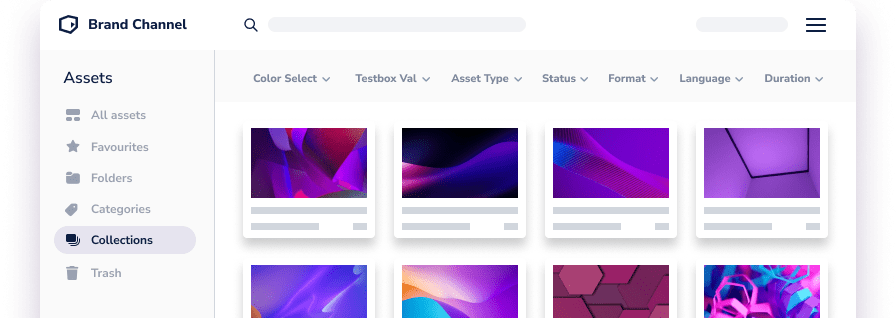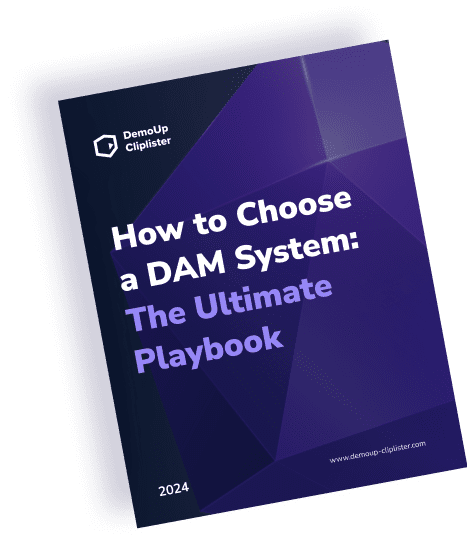Why Digital Asset Management Is Crucial for E-Commerce
Digital Asset Management
Updated on February 17, 2025
Digital asset management (DAM) is an organisation’s process for the storage and retrieval of digital resources that includes online content, multimedia and other digital assets.
Digital asset management systems are tools to maintain scale the creation and use of the digital assets needed to increase the visibility of your business and products, and enable your team to convey a clear and effectively branded message.
The following guide provides insights into why digital asset management is crucial for e-commerce brands and shops, signs you may need to change your system, and how to gauge the value a solution can bring your business.
What does a DAM solution do?
Digital asset management solutions are software applications used for archiving, storing and transferring digital assets. But as technology improves, the use cases become far more broad.
Now, a DAM solution acts not only as a single source of truth for your content, but also as a centralised system for the creation, management, organisation, and delivery of digital assets to your stakeholders, customers, and even your website.
What is a Digital Asset?
Digital assets are defined in digital formats as any type of uniquely identifiable digital material that exists legally belonging to a business. In this way, the definition of digital assets is truly unlimited.
Here is a list of some digital asset examples and their file types:
- Images: .jpeg, .png, .gif, .svg, .webp
- Videos: .mp4, .avi, .mov, .mkv
- Audio: .mp3, .wav, .flac, .aac
- 3D & AR Models: .3ds, .obj, .stl, .step
- Documents: .docx, .xlsx, .csv, .pptx
- Archives & Compressed Files: .zip, .rar, .7z
- And more
As you can see, any DAM software worth its salt should be the backbone of your organisation. Its use should go far beyond your sales and marketing teams and help all stakeholders access digital assets and consolidate redundant tools across your enterprise.
Why Digital Asset Management is Important for E-Commerce

Digital asset management can reduce costs for organisations, increase productivity, and enhance workflows. However, the benefits of digital asset management vary by industry.
So, if you are looking for a DAM system to fit specific use cases, there is likely one for it. Some industries like legal and healthcare require systems that differ from what marketing teams at e-commerce companies may look for.
For instance, we developed our digital asset management software for the specific needs of e-commerce brands and shops. And even then, the use cases are completely different. Here are our four most common use cases:
Use Case 1: E-Commerce Digital Asset Management for Brands
While most DAM software offers brand consistency as a unique selling proposition, not many can deliver on this promise in the e-commerce arena. Some brands offer thousands of products, requiring millions of digital assets like images and product videos.
Ensuring that all of this content is up-to-date on retailer product detail pages (PDPs) is a mammoth task, and typically involves many spreadsheets, long email chains, and manual follow-ups.
With the DemoUp Cliplister DAM software, you can solve this problem using our syndication feature. Simply upload your product assets, input their EANs, and they display on the PDPs of every retailer connected to the network.
Easy, right?
If you are an e-commerce brand struggling with brand consistency, be sure to check out our software on a free personalised demo.
Use Case 2: Digital Asset Management for e-commerce Retailers
Online retailers, on the other hand, have a different problem. They need to not only manage millions of assets efficiently, but they also need to acquire content from brands, ensure it’s up-to-date to avoid digital rights management violations and create their own assets for digital merchandising.
The challenge then becomes, how can your online shop deliver a personalised customer experience without creating all these assets manually?
To solve this side of the equation, we offer our online shop clients access to the digital assets uploaded to our network by brands. On top of this, our multi-CDN service ensures your product videos and images are delivered to the front end of your shop as fast as possible
This is important because speed counts in online retail. Each 1-second delay in page speed can cause a 7% reduction in conversions.
To solve this, we also developed our dynamic image delivery technology which optimises your images at scale, adjusts them based on pre-specified breakpoints, and always ensures your customers get the most optimised image for their device.
Use Case 3: Support Your E-Commerce Video Marketing Strategy
E-Commerce video marketing is a huge topic. Videos are typically big and come in various formats, causing difficulty in the management, delivery and support of product media.
DemoUp Cliplister is a combined video asset management software solution and product content syndication network all in one, with some media asset management capabilities built in.
The result is a unique platform built specifically for e-commerce brands and shops.
Brands can upload their product videos, 3D models, and product images, and deliver them directly to the digital point of sale.
In other words, you can sync your product media with the gallery of any connected shop. Automatically.
On the retailer side, your team can now acquire and deliver videos that are right for each visitor with our CDN — regardless of the screen size, bandwidth, or type of device.
Use Case 4: Powering Product Content Management
Product content management is a huge challenge for both brands and online shops. It’s common to combine DAM solutions with existing PIM or PXM technologies.
As part of a product information management (PIM) or product experience management (PXM) stack, an e-commerce DAM system helps power efficient content delivery from brands to retailers, to customers.
Other Benefits of Digital Asset Management Systems
While we specialise in e-commerce, there are several other ways digital asset management benefits organisations. Here are the most common:
Integrate Your Marketing Tech (Martech) Stack
Modern DAM system features are clean and efficient, but they’re not going to be a complete solution. Thankfully, many modern DAM systems are packed with integration tools allowing teams to use their preferred apps through their workflow.
However, some of these tools may not offer the flexibility required by some businesses. It may be worth investigating a headless DAM option, like ours, where you can customise all your integrations using an application programming interface (API) connection.
That being said, digital asset management software does play a key part in optimizing existing tools. Not only can you organise digital assets, inventory existing assets, and share with internal and external stakeholders, you can integrate with existing systems to create a 360-degree martech stack.
Different DAM solutions integrate better with some tools than others. Common integrations of our DAM system with other tools include:
- Product Information Management (PIM) systems
- Content Delivery Networks (CDNs)
- Product Experience Management (PXM) tools
- Content Approval Software (CAS)
- Project Management (PM) tools
- Content Management Systems (CMS)
Repurpose High Performing Content
DAM software helps your organisation enhance the value of their digital media by identifying high-quality content for reuse. It allows you a better way to adapt your existing digital assets and improve their quality.
With an unparalleled level of accessibility to all past and current media, you can add life to any finished project.
Streamline the Content and Media Lifecycle
Most companies use a suite of tools to manage the content lifecycle. You need content creation tools to make the creative assets, content management systems to ensure it’s delivered to the right place, planning materials and software so it’s done on time, and so on.
A digital asset management system streamlines this process by providing a platform for the creation, sharing and managing of all branded content, helping to facilitate ideas, create assets and publish them from a centralised location.
Measure the ROI and Performance of Digital Assets
All departments must produce reports for stakeholders. A digital asset management system provides a platform to manage and control digital assets from anywhere to any location.
Plus, DAM systems are used to improve digital assets management across various channels and to consolidate performance reports across product categories, geographic locations and audiences, thus providing valuable insights into how your content performs.
Consolidate Redundant Tools and Automate Repetitive Tasks
The many benefits of a DAM’s work can also be identified in how many redundant functions and abilities they consolidate. DAM systems can be adapted and automated in many ways to enable your business to focus on its key areas – building and growing the business identity.
Minimise Legal Risk and Ensure Compliance With Usage Rights
If you are in charge of branding, you’ll likely be familiar with legal compliance requirements. Marketing teams must monitor the utilisation of licenced images, videos, or other content.
Licences also vary between regions of the world. A digital asset management solution allows your employees to maintain full compliance by allowing your staff to set and maintain user permissions, edit and change metadata, and input validity dates for the usage of specific digital files.
Support Sales Channels and Marketing Channels
Marketing and sales teams must collaborate to produce the content necessary for the business to deliver high-converting assets. For this to happen, there must be quick & efficient digital communication.
Most digital asset management platforms feature version control. This is one of the main benefits of digital asset management (DAM) tools and helps ensure brand consistency during asset handoffs between your sales and marketing organisations, external partners, and other stakeholders.
You Have Remote Teams
In the post-pandemic era, more teams have moved to remote work. But how do you make it easy to access assets?
With DAM solutions, you can host all your media files in a centralised repository. DAM tools provide secure storage and custom user access rights to all your organisational assets.
This means you can give users in multiple locations quick and easy access to all your creative workflows, brand guidelines, and rich media files. Not to mention, this enables your marketing team to provide quick and easy access to partners who need to publish up-to-date marketing assets.
When Do I Need To Invest In A DAM Platform?
Signs You Need a DAM System
You Need to Consolidate Redundant Tools
You Need to Scale Digital Content Production
You Lack a Consistent Brand Message
Your Teams Are Disorganised
You Lack Security
If your team spends loads of time looking for digital assets that could be solved with search functionality, needs to centralise all your digital assets and brand assets in one place, or wants to reduce operational costs – it’s time.
While these are the most common key benefits of digital asset management solutions, here are some other signs it may be time to invest in a DAM solution.
1. You Need to Consolidate Redundant Tools
Digital asset management has progressed far beyond file sharing and storing assets. It’s now an information management technology that serves as the backbone of your project management, marketing content operations, and process automation.
For instance, if you use separate tools for creating visual assets, sharing them, and storing them while producing other marketing materials, you would probably benefit from one of the top DAM solutions.
2. You Need to Scale Digital Content Production
The need to scale digital content production is a crucial indicator for investing in a DAM platform. As your content creation efforts expand, so do the challenges of managing and organizing digital assets efficiently.
A top-tier DAM solution streamlines workflows, facilitates collaboration, and enhances productivity, allowing your team to scale content production quickly.
Whether it’s accelerating the creation of visual assets, optimizing distribution processes, or ensuring brand consistency across all channels, a DAM platform empowers your team to meet the demands of today’s customers while maintaining operational efficiency.
3. You Lack a Consistent Brand Message
A consistent brand image is key in modern marketing. If your organisation struggles to uphold brand consistency across various channels and touchpoints, it’s a clear sign you need digital asset management software.
By providing a single source of truth for brand assets, DAM solutions ensure all team members have access to the latest approved digital content and marketing materials, reducing the risk of inconsistencies in messaging and media assets.
4. Your Teams Are Disorganised
If your teams struggle to locate and collaborate on digital assets effectively, you probably need a DAM system. A sophisticated DAM solution provides a central repository for all digital assets, ensuring easy access and seamless collaboration across departments and projects.
With features such as advanced search functionalities, customisable metadata, and permission-based access controls, a DAM platform streamlines workflows and fosters better communication among team members.
In other words, digital asset management tools empower your teams to work more efficiently and achieve their goals effectively. You can learn more about how to organise digital content and manage assets in our digital asset management implementation guide.
5. You Lack Security
rotecting your digital assets is crucial in today’s business environment. If your team doesn’t have a solid plan in place to safeguard important files and information, it’s time to consider investing in a DAM system.
DAM solutions provide added layers of security such as encryption, strict access controls, and detailed audit logs. These features help keep out unauthorised users and defend your data against cyber threats.
Plus, having all your assets securely stored in one central location makes it easier to maintain compliance and ensure data integrity. If you’re serious about protecting your digital assets, or want to secure access to your valuable resources, a DAM system is the way to go.
How to Choose a Digital Asset Management Solution
If you are convinced you need a digital asset management solution – good.
It is an efficient and effective way to manage digital content, reduce time to market, eliminate waste and optimise costs.
But what should you look for in a DAM software solution?
Luckily, we created a guide that answers exactly this question. Read our article on “How to Choose a Digital Asset Management System” for a complete overview.

Comparing DAM providers? Download our free playbook!
Download Now For FreeHow to Calculate the Value of DAM Software
Calculating the value of your digital asset management software is essential for maximizing its benefits. Begin by assessing the specific features and functionalities it offers, such as organisation, accessibility, and security. Consider the time saved in locating assets and the efficiency gained in collaboration.
Evaluate how the software enhances brand consistency and protects valuable digital assets from loss or unauthorised access.
Factor in the potential cost savings from reduced storage needs and minimised risks of legal or reputational damage. Additionally, gather feedback from users to gauge overall satisfaction and productivity improvements.
By taking a comprehensive approach to assessing the value of digital asset management tools, you can make informed decisions about its effectiveness and ensure that it continues to deliver significant benefits for your organisation.
Conclusion
There are several reasons why you might want to look into DAM platforms. As you can see, they are no longer simple servers tasked with storing assets.
They have evolved into comprehensive content operations tools and can provide you with one central location to manage the entire content lifecycle.
For more information on digital asset management, e-commerce content creation, or content syndication, be sure to check out the blog.
To see our entire product portfolio, visit the homepage.
Digital asset management is a system used to store, organise, and retrieve digital files such as images, videos, documents, and other media assets.
DAM enhances efficiency by allowing easy access and retrieval of digital assets, reducing time spent searching for files and enabling quicker content updates and distribution.
DAM ensures that all digital assets are up-to-date and easily accessible, allowing businesses to maintain consistent branding across all marketing channels and platforms.
Yes, DAM facilitates collaboration by providing a centralised repository where teams can access, share, and manage digital assets, leading to improved teamwork and communication.
By streamlining workflows and reducing the time spent managing digital assets, DAM can lower operational costs, increase productivity, and provide a better return on investment for businesses.
Better Content. More Sales.

Fill out the form to discover our end-to-end eCommerce content solutions for brands & shops




